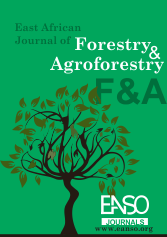Community Knowledge and Perception of Indigenous Tree Species in Bugesera District, Rwanda
Abstract
Indigenous tree species play a critical role in maintaining biodiversity, supporting livelihoods, and enhancing ecosystem resilience in Rwanda. However, their survival is threatened by deforestation, agricultural expansion, and erosion of traditional knowledge. This study assessed community knowledge, perceptions, and conservation practices related to indigenous tree species in the Ntarama Sector, Bugesera District, Rwanda. A mixed-methods approach was employed, combining surveys (n = 381), focus group discussions (n = 18), and key informant interviews (n = 11). The study documented 20 indigenous tree species, with Ficus thonningii, Albizia gummifera, and Prunus africana being the most recognized. While 90% of respondents were familiar with indigenous species and 85% acknowledged their ecological and socio-economic benefits, only 10% of younger individuals demonstrated awareness, highlighting a generational knowledge gap. Deforestation (95%), climate change (85%), and overharvesting (55%) were identified as major threats. Despite 90% expressing positive attitudes toward conservation, only 65% actively participated in sustainable practices, with financial constraints (35%) and land scarcity (20%) cited as key barriers. Regression analysis revealed that knowledge level (β = 0.72, p < 0.001) and institutional support (β = 0.42, p = 0.009) significantly influenced conservation adoption. The findings underscore the need for integrated strategies that combine traditional knowledge with modern conservation approaches, enhance community education, and provide economic incentives. Policy recommendations include strengthening institutional frameworks, promoting drought-resistant species, and fostering community-led conservation initiatives to ensure the long-term preservation of indigenous trees in Rwanda and similar regions
Downloads
References
Ajzen, I. (1991). The theory of planned behavior. Organizational Behavior and Human Decision Processes, 50(2), 179–211.
Bigirimana, C., Nsabimana, D., Ntirugulirwa, B., Nsengimana, V., Steppe, K., & Boeckx, P. (2016). Utilisation of indigenous fruit tree species within the Lake Victoria Basin, Rwanda. Agricultural Science: An International Journal, 1(1), 1–13.
Bronfenbrenner, U. (1979). The ecology of human development: Experiments by nature and design. Harvard University Press.
Chidumayo, E. N., & Gumbo, D. J. (2010). The dry forests and woodlands of Africa: Managing for products and services. Routledge.
Food and Agriculture Organization (FAO). (2020). Global Forest Resources Assessment 2020. FAO.
Gadgil, M., Berkes, F., & Folke, C. (1993). Indigenous knowledge for biodiversity conservation. Ambio, 22(2–3), 151–156.
Government of Rwanda (GoR). (2018). Rwanda Forest Policy. Ministry of Environment.
International Union for Conservation of Nature (IUCN). (2022). Restoring forest landscapes in Eastern Province of Rwanda.
Leventon, J., Kalaba, F. K., Dyer, J. C., Stringer, L. C., & Dougill, A. J. (2019). Delivering community-based conservation through the community resource management area mechanism in Ghana. Conservation Science and Practice, 1(6), e50.
Mukeshimana, E., & Rizinjirabake, F. (2024). Perception and knowledge of local community on the use of indigenous tree species for ecosystem restoration in Gasabo District, Rwanda. Rwanda Journal of Engineering, Science, Technology and Environment, 6(1), 1–19.
Mutangya, M., Mbuvi, M. T. E., & Kungu, J. (2018). Indigenous knowledge systems and their role in forest conservation in Africa. African Journal of Ecology, 56(3), 507–517.
National Institute of Statistics of Rwanda (NISR). (2022). Rwanda Population and Housing Census 2022. NISR.
Nsabimana, D., Klemedtson, L., Kaplin, B. A., & Wallin, G. (2018). The role of agroforestry in enhancing biodiversity in Rwanda. Agroforestry Systems, 92(2), 409–422.
Rwanda Environment Management Authority (REMA). (2019). State of Environment Report for Rwanda 2019. REMA.
United Nations Environment Programme (UNEP). (2019). Global Environment Outlook 6. UNEP.
Copyright (c) 2025 Emmanuel Masengesho, Christophe Mupenzi, PhD, Emmanuel Hakizimana, PhD

This work is licensed under a Creative Commons Attribution 4.0 International License.




























